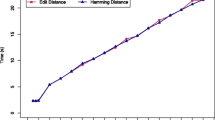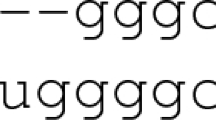Summary
Minimum message length encoding is a technique of inductive inference with theoretical and practical advantages. It allows the posterior odds-ratio of two theories or hypotheses to be calculated. Here it is applied to problems of aligning or relating two strings, in particular two biological macromolecules. We compare the r-theory, that the strings are related, with the null-theory, that they are not related. If they are related, the probabilities of the various alignments can be calculated. This is done for one-, three-, and five-state models of relation or mutation. These correspond to linear and piecewise linear cost functions on runs of insertions and deletions. We describe how to estimate parameters of a model. The validity of a model is itself an hypothesis and can be objectively tested. This is done on real DNA strings and on artificial data. The tests on artificial data indicate limits on what can be inferred in various situations. The tests on real DNA support either the three- or five-state models over the one-state model. Finally, a fast, approximate minimum message length string comparison algorithm is described.
Similar content being viewed by others
References
Allison L, Yee CN (1990) Minimum message length encoding and the comparison of macro-molecules. Bull Math Biol 52(3): 431–453
Allison L, Wallace CS, Yee CN (1990) When is a string like a string? Proceedings, Artificial Intelligence and Mathematics, Ft. Lauderdale FL
Allison L, Wallace CS, Yee CN (1992) Minimum message length encoding, evolutionary trees and multiple alignment. Hawaii Int Conf Sys Sci (in press)
Bains W (1986) The multiple origins of the human Alu sequences. J Mol Evol 23:189–199
Bishop MJ, Friday AE (1986) Molecular sequences and hominoid phylogeny. In: Wood B, Martin L, Andrews P (eds) Major topics in primate and human evolution. Cambridge University Press, Cambridge, pp 150–156
Bishop MJ, Rawlings CJ (eds) (1987) Nucleic acid and protein sequence analysis, a practical approach. IRL Press
Bishop MJ, Friday AE, Thompson EA (1987) Inference of evolutionary relationships. In: Bishop MJ, Rawlings CJ (eds) Nucleic acid and protein sequence analysis, a practical approach. IRL Press, pp 359–385
Boulton DM, Wallace CS (1969) The information content of a multistate distribution. J Theor Biol 23:269–278
Boulton DM, Wallace CS (1973) An information measure for hierarchic classification. Comput J 16:254–261
Chaitin GJ (1966) On the length of programs for computing finite binary sequences. J Assoc Comput Mach 13(4):547–569
Cohen DN, Reichert TA, Wong AKC (1975) Matching code sequences utilizing context free quality measures. Math Biosci 24:25–30
Felsenstein J (1981) Evolutionary trees from DNA sequences: a maximum likelihood approach. J Mol Evol 17:368–376
Georgeff MP, Wallace CS (1984) A general selection criterion for inductive inference. Proceedings, European Conference on Artificial Intelligence, pp 473–482
Gotoh O (1982) An improved algorithm for matching biological sequences. J Mol Biol 162:705–708
Gotoh O (1990) Optimal sequence alignment allowing for long gaps. Bull Math Biol 52(3):359–373
Hamming RW (1980) Coding and information theory. Prentice Hall, Englewood Cliffs NJ
Hirschberg DS (1975) A linear space algorithm for computing maximal common subsequences. Commun Assoc Comput Mach 18(6):341–343
Holmes EC (1989) Pattern and process in the evolution of the primates. PhD thesis, Cambridge University
Jurka J, Milosavljevic A (1991) Reconstruction and analysis of human Alu genes. J Mol Evol 32:105–121
Kolmogorov AN (1965) Three approaches to the quantitative definition of information. Probl Inf Transmission 1(1):1–7
Langdon GG (1984) An introduction to arithmetic coding. IBM J Res Dev 28(2):135–149
Li M, Vitanyi PMB (1988) Two decades of applied Kolmogorov complexity. Proceedings of the Third Annual Conference on Structure in Complexity Theory. IEEE, pp 80–101
Miller W, Myers EW (1988) Sequence comparison with concave weighting functions. Bull Math Biol 50(2):97–120
Milosavljevic AD (1990) Categorization of macromolecular sequences by minimal length encoding. PhD thesis, University of California at Santa Cruz, UCSC-CRL-90–41
Needleman SB, Wunsch CD (1970) A general method applicable to the search for similarities in the amino acid sequence of two proteins. J Mol Biol 48:443–453
Reichert TA, Cohen DN, Wong KC (1973) An application of information theory to genetic mutations and the matching of polypeptide sequences. J Theor Biol 42:245–261
Rissanen J (1983) A universal prior for integers and estimation by minimum description length. Ann Stats 11(2):416–431
Sankoff D, Kruskal JB (eds) (1983) Time warps, string edits and macro-molecules. Addison Wesley
Sellers PH (1974) On the theory and computation of evolutionary distances. SIAM J Appl Math 26(4):787–793
Sellers PH (1980) The theory and computation of evolutionary distances: pattern recognition. J Algorithms 1:359–373
Shepherd JCW (1981) Method to determine the reading frame of a protein from the purine/pyrimidine genome sequence and its possible evolutionary justification. Proc Natl Acad Sci USA 78:1596–1600
Solomonoff R (1964) A formal theory of inductive inference, I and II. Inf Control 7:1–22, 224–254
Thorne JL, Kishino H, Felsenstein J (1991) An evolutionary model for maximum likelihood alignment of DNA sequences. J Mol Evol (in press)
Ukkonen E (1983) On approximate string matching. In: Karpinski M (ed) Proceedings of an international conference on foundations of computation theory, vol 158. Springer Verlag, pp 482–495
Wallace CS (1990) Classification by minimum message length inference. AAAI Spring Symposium on the Theory and Application of Minimum Length Encoding, Stanford, pp 5–9
Wallace CS, Boulton DM (1968) An information measure for classification. Comput J 11(2):185–194
Wallace CS, Freeman PR (1987) Estimation and inference by compact coding. J R Star Soc B 49(3):240–265
Waterman MS (1984) General methods of sequence comparison. Bull Math Biol 46(4):473–500
Witten IH, Neal RM, Cleary JG (1987) Arithmetic coding for data compression. Commun Assoc Comput Mach 30(6):520–540
Wong AKC, Reichert TA, Cohen DN, Aygun BO (1974) A generalized method for matching informational macromolecular code sequences. Comput Biol Med 4:43–57
Author information
Authors and Affiliations
Additional information
Offprint requests to: L. Allison
Rights and permissions
About this article
Cite this article
Allison, L., Wallace, C.S. & Yee, C.N. Finite-state models in the alignment of macromolecules. J Mol Evol 35, 77–89 (1992). https://doi.org/10.1007/BF00160262
Received:
Revised:
Accepted:
Issue Date:
DOI: https://doi.org/10.1007/BF00160262




